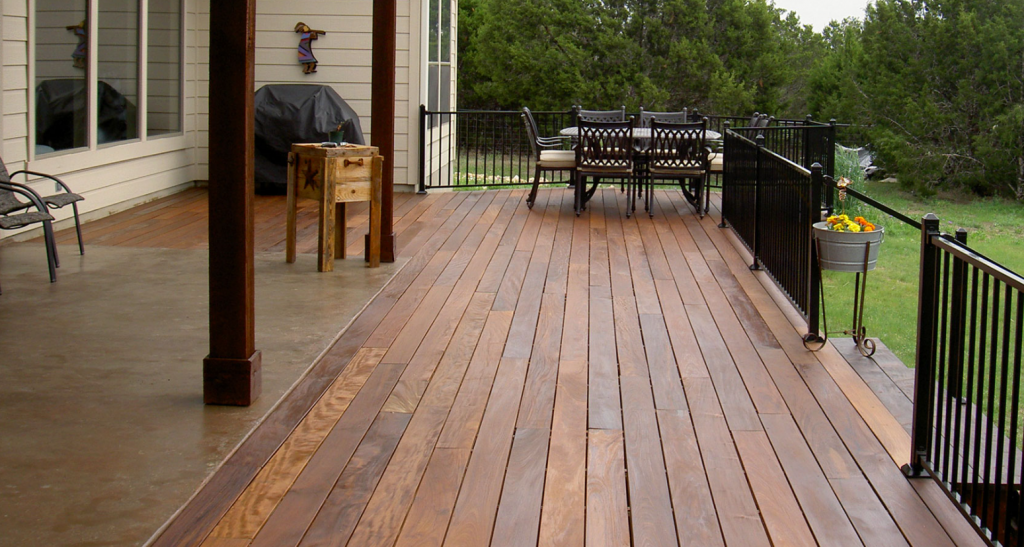Ipe wood is a tropical hardwood species native to South America, Central America, and Northern Brazil. It can be found in forests near the coast or rivers where there are shady areas with high levels of rainfall. The wood looks amazing due to its distinctive grain pattern that varies from one piece to another.

It is most often used for furniture, flooring, and paneling. Ipe is often referred to as the best wood in the world for resisting rot and insects. Ipe wood is a popular species for outdoor projects because of its natural weather-resistant qualities. In this article, we cover what ipé wood is, how it differs from other types of wood, and why ipe has been so popular.
Why Is Ipe Wood So Popular?
Ipe is a tropical hardwood with great looking and amazing woodworking properties. Ipe wood is considered to be one of the most expensive types because it contains larger knots and tighter grain patterns than Ash or Sapodilla ipe, which include only a few knots per inch (1″). Each type exhibits unique characteristics when used for furniture and paneling.

Unlike other tropical hardwoods that lose some of their strength when dried, ipé wood undergoes little to no change in strength when exposed to air. The wood is not affected by moisture or temperature changes and shows very little dimensional change.
The wood is resistant to decay, insects, rot, and fire. Ipe wood is commonly found in West Africa, and it has long been used for furniture and paneling in tropical regions. The trees also hold up well against hurricanes, winds, and other extreme elements, making them an excellent choice for outdoor projects and indoor furniture.
Strength And Other Properties Of Ipe Wood
Ipe wood is extremely hard and heavy but also very stiff and strong. The wood has a Janka hardness rating of 3,150 pounds. The high hardness makes it one of the more resilient hardwoods available. The strength rating of ipe is among the highest-rated compared to other woods.

The grain pattern of ipe wood is very interesting. Details on the direction of the grain, knots, and their density can vary greatly from one piece to another depending on the tree’s location and care. The natural color of ipe wood tends to be light orange or pinkish brown. But when used for outdoor projects, you may see some pieces with dark brown or even dark red hues in them.
The wood is naturally resistant to different damages. It does not contain any lignin that can break down into other substances such as cellulose and hemicellulose. When Ipe wood is exposed to water, it turns a light orange color but remains resistant to decay.
Benefits Of Ipe Wood
In addition to the physical characteristics, ipe wood has an advantage over other woods because of its natural oils and waxes that give it natural rot and insect resistance. Below there are additional benefits of this tree type.
Hardness
Ipe wood is one of the hardest woods that there is in nature. It has been ranked by the Janka hardness scale as being more than 3,000 pounds per square inch, making it one of the hardest woods in existence.
The hardness of ipe wood makes a great addition to outdoor projects where there will be objects exposed to the elements such as rain or snow that may negatively affect other woods or building materials.
Rot Resistance
The hardness of ipe wood makes it resistant to rot and fire. The wood is not affected by moisture or temperature changes when it remains dry, but when wet, the wood turns up to a light orange color. Even when dry, it still maintains its strength.
Insect Resistance
Ipe wood is also one of the best wood species in terms of insect resistance due to its low lignin content, and high tough fibers make it easy for insects to not bite through the tiny fibers on their bodies.
The Bottom Line
Ipe wood is one of the best woods in the world that can be used for various things regarding the durability and stability it offers. Ipe wood is not only used for outdoor projects because it also has an excellent aesthetic quality that enhances the look of any type of furniture or building materials such as flooring, tabletops, beams, and panels, along with many other options.
In addition to the physical characteristics, ipe wood has an advantage over other woods because of its natural oils and waxes that give it natural rot and insects resistance. With all these great benefits, ipe wood is a great option to use for many applications.